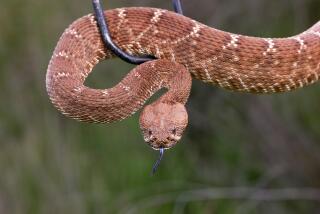Snakes Just Want to Be Left Alone
NEW ELLENTON, S.C. — Before stepping down the short wooden staircase into the pit, researcher Xavier Glaudas nonchalantly explains what lies beneath.
Poisonous snakes -- about 40 of them.
“They are mostly all copperheads. There are some canebrake rattlesnakes, and there is one diamondback,” he says, grabbing a snake tong modified to look like a human arm.
It’s a tool the graduate student from Lyon, France, is using to study the aggressiveness of copperheads. And what he’s finding is similar to what other studies of snakes have shown -- the creatures are not very aggressive and would rather slither away than confront humans.
“Snakes. Why’d it have to be snakes?” Indiana Jones muttered before dropping into an infested ruin in search of the Ark of the Covenant. The movie hero wouldn’t like it here much better.
The snake pit at the University of Georgia’s Savannah River Ecology Laboratory, about an acre of land surrounded by a solid fence, has a small pond with a sunken canoe in the middle.
The steps descend about 6 feet into the pit from a wooden observation platform. At one end, the area is overgrown with grass and shrubs, at the other, tall pines shade the ground and part of the pond.
“Most snake bites occur when people pick them up,” says Whit Gibbons, a senior ecologist and a professor at the lab. “These snakes are not aggressive.”
Several years ago Gibbons studied the aggressiveness of cottonmouths. And researchers at Stetson University in Florida, in work with pygmy rattlesnakes, made similar findings.
In the Stetson study, Glaudas says, most of the snakes, even when poked on the head three times, did little to respond. Out of 620 snakes studied, about 50 struck.
Although his research on copperheads won’t be finished before winter, Glaudas says they appear to react in a similar way.
“One conclusion I can make from my studies is you would be amazed at how hard it is to get a snake to strike you,” he says. “If a snake gets you, there’s a large probability you are doing everything for that to happen.”
Walking through the snake pit, he lifts pieces of plywood scattered around to provide hiding places for the snakes. On this warm summer day, none is found beneath the first few pieces laying in hot, direct sunlight.
But then, as he flips up a piece of wood beneath the shade of a tree, Glaudas uncovers a copperhead and a canebrake rattler. He pokes the copperhead several times with the tongs and it strikes; the rattler doesn’t.
Snakes rely first on their camouflage coloring to stay out of the way of humans and predators. If they sense danger, they try to slink away. But, if provoked, they will give a warning display as though they intend to strike. They strike only as a final option.
People are more likely to be bitten if they come upon a snake that is moving and feels threatened because it is not in a safe place.
“If you try to catch a snake on the road, he’s probably going to bite or try to defend itself,” he says. “That’s how we find copperheads -- we cruise the roads at night.”
On a road, even from a relatively long distance, a snake might strike.
“It’s a warning display. Even though they don’t have the purpose of hitting you, it’s telling you: ‘I can strike. Back off,’ ” Glaudas says.
But even people who spend a lot of time outdoors have little chance of being bitten.
“The real question is -- and we will never have an answer to -- is how many people cross by a snake and never detect it and never report it?” he says.
So then why do so many people dislike snakes?
“I think it’s biblical. It just may be the Bible image of the snake as a bad thing -- the tempter,” Glaudas says. “They crawl, and people don’t like it that they don’t have legs and are so different” from humans.
“They’re totally misunderstood. They just want to be left alone.”
More to Read
Sign up for Essential California
The most important California stories and recommendations in your inbox every morning.
You may occasionally receive promotional content from the Los Angeles Times.









